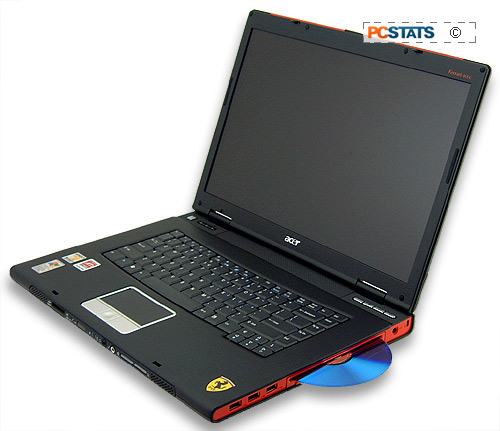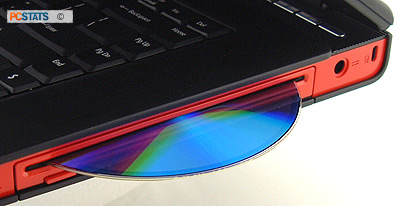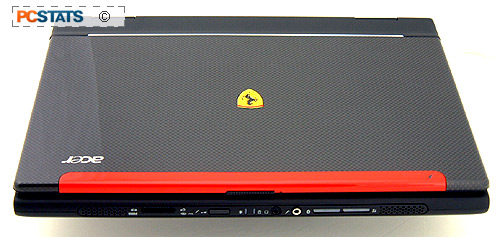 The Ferrari 4005 WLMi
uses ATI's Radeon Xpress 200P chipset, which is actually intended for desktop
Athlon 64 processors.
The Ferrari 4005 WLMi
uses ATI's Radeon Xpress 200P chipset, which is actually intended for desktop
Athlon 64 processors.
This recent ATI chipset
supports Hypertransport (as it must to connect with AMD's 64-bit processors),
DDR-3200 memory, PCI Express video and peripherals and SATA
I. The Radeon Xpress 200P chipset supports both dual and
single-channel memory configurations, but in the case of this laptop only single
channel is available.
The ATI Radeon Mobility X700 is ATI's top mobile graphics processor, and with 128MB of
memory, it should have plenty of grunt for demanding games like Doom3 and Half-Life
2. The Radeon Mobility X700 is based on ATI's X700 desktop graphics processor,
and should have somewhat equivalent performance. The 15.4"
wide screen LCD has a huge native resolution of 1680 x 1050 (WSXGA+).
The Acer
Ferrari 4005 WLMi's battery is a
71W Lithium-Ion pack that slots into the rear of the laptop. It's rated at
14.8V and
4800mAh.
The Acer Ferrari 4005 WLMi features several connection
options besides the aforementioned network adaptors. A 5-in-1 memory card reader
handles SD and XD cards, Memory Stick, Memory Stick Pro and MMC formats, though
sadly not Compact Flash or Smartmedia.  Four USB
2.0 ports and an IEEE 1394 connector allow for external peripherals to be
hooked up, and VGA and S-video connectors handle monitor-out and
TV-out duties respectively.
Four USB
2.0 ports and an IEEE 1394 connector allow for external peripherals to be
hooked up, and VGA and S-video connectors handle monitor-out and
TV-out duties respectively.
Audio is provided by the ubiquitous AC'97 audio codec, though Acer
have added SPDIF support to the front audio jack for driving digital speakers. Dual
front dash speakers provide on-board sound.
The Acer Ferrari 4005 WLMi is a two-spindle notebook with a 5400RPM
100GB hard disk and an 8x Panasonic slot loading super-multi dual-layer
DVD burner. The addition of dual-layer burning capability is a nice touch
and should endear this notebook to multimedia enthusiasts.

One thing confused us about the Acer Ferrari 4005 WLMi: It's using a 64-bit AMD Turion
mobile processor that can support DDR-400 memory and a chipset (ATI Xpress 200P)
that is capable of supporting DDR-400 memory, yet the notebook ships with
PC-2700 DDR-333 memory instead. Combined with the single-channel only
configuration of the motherboard, we can't help but think that this will drag
down system performance unnecessarily. There may be an incompatibility we are
not aware of here, but it seems obvious that adding DDR-400 memory would
increase overall system performance in this case.
